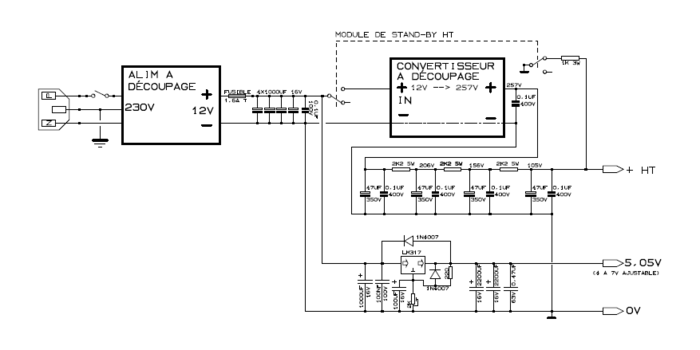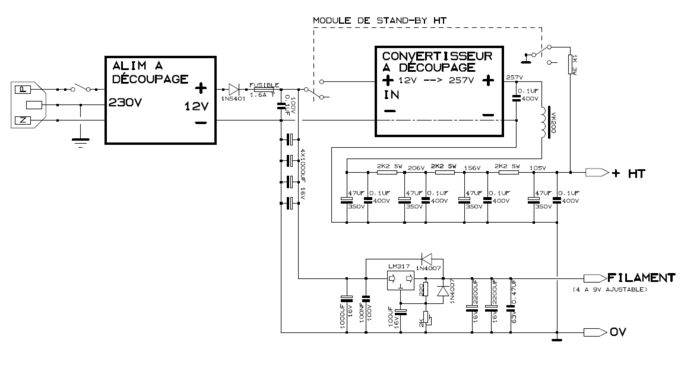Micro U47
- 1 058 réponses
- 33 participants
- 119 587 vues
- 45 followers
berl
Le schéma d'Oliver Archut avec un tube EF14 me plaît bien, et la réalisation ne me semble pas trop compliquée...
Voilà l'EF14 arrivée ce matin :
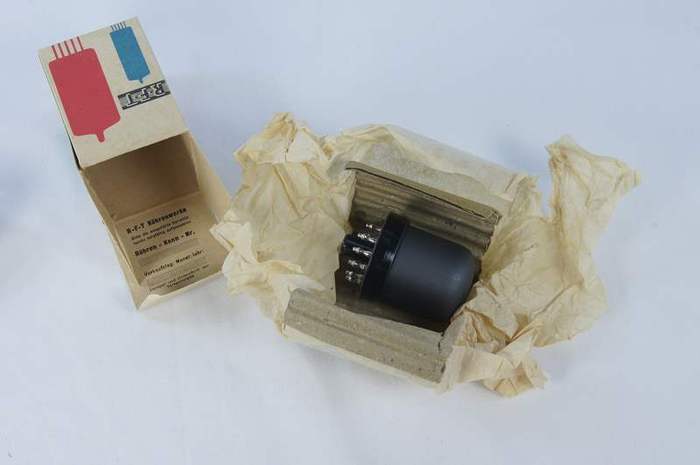
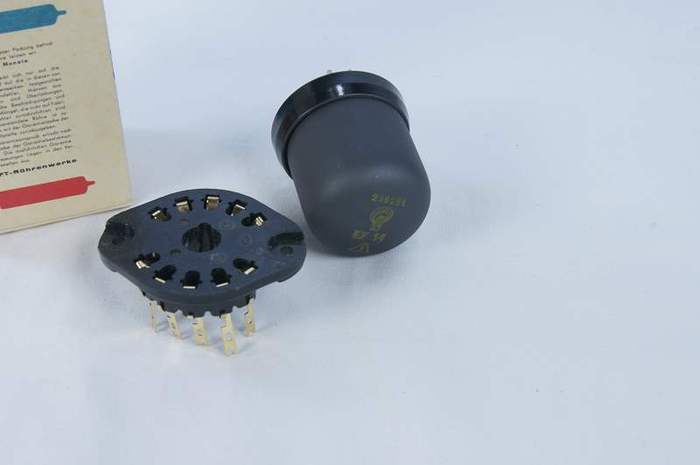
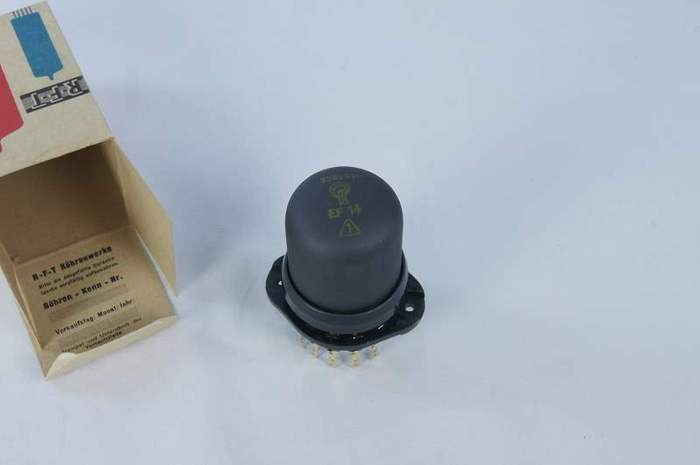
Je pense prendre une capsule RK7 Microphone-Parts (vos avis ???) et un transfo AMI BV8R.
Pour le corps, je ne sais pas encore si je le fabrique ou je le récupère... c'est selon ce que je trouverai.
Bernard
http://sonotrad.org --- http://diato.org --- "Collectionneur" de tables numériques Innovason et de micros DIY --- Fer à souder toujours chaud...
berl
J'ai modifié sur le schéma. Et le fusible c'est pas mal quand on fait une connerie, vu qu'il n'y en a pas sur le module à découpage...
J'ai mis une VK200 chère à Chimimic en entrée de filtrage HT, mais je pense que pour une action sur la fréquence de découpage (~100 à 150 kHz) il faudrait bien plus que 10uH
Bernard
http://sonotrad.org --- http://diato.org --- "Collectionneur" de tables numériques Innovason et de micros DIY --- Fer à souder toujours chaud...
[ Dernière édition du message le 30/09/2014 à 01:31:12 ]
berl
Bernard
http://sonotrad.org --- http://diato.org --- "Collectionneur" de tables numériques Innovason et de micros DIY --- Fer à souder toujours chaud...
scare
C est une diode vers le fusible sur le veroboard ?
Construction du nouveau studio
Visitez le site THD STUDIO / page FB THD Studio
Dossier : Conversion analogique-numérique (pour les courageux)
scare
Construction du nouveau studio
Visitez le site THD STUDIO / page FB THD Studio
Dossier : Conversion analogique-numérique (pour les courageux)
berl
C est une diode vers le fusible sur le veroboard ?
Oui, ça c'est un essai : pour que le module HT se coupe immédiatement à la coupure secteur, il est alimenté directement à la sortie du module 12V.
Après, la diode empèche que les condos qui se déchargent n'alimentent le module temporisateur qui dans ce cas ne va pas couper la HT immédiatement.
Dans notre schéma, avec 22mA de HT les condos se déchargent assez vite quand même (moins de 10 secondes) donc pas de risque pour le tube si la tempo ne se coupe pas immédiatement.
Mais c'était un essai, et pour d'autres types de micros (sans 22mA de HT) ça me semble un bon principe.
Bernard
http://sonotrad.org --- http://diato.org --- "Collectionneur" de tables numériques Innovason et de micros DIY --- Fer à souder toujours chaud...
[ Dernière édition du message le 30/09/2014 à 01:43:25 ]
berl
C est pas mieux de ne pas relier la masse de la ht a la masse du circuit heater ?
Je ne vois pas comment on pourrait faire autrement. Il faut référencer le filament à un potentiel de toutes façons, et la mise à la terre du corps du micro est impérative (donc la masse à la terre).
Dans le cas de l'alim à découpage, la question ne se pose d'ailleurs pas : le module convertisseur convertit le +12V en 200~450V avec la masse commune (en pointillé sur le schéma).
Bernard
http://sonotrad.org --- http://diato.org --- "Collectionneur" de tables numériques Innovason et de micros DIY --- Fer à souder toujours chaud...
berl
Bernard
http://sonotrad.org --- http://diato.org --- "Collectionneur" de tables numériques Innovason et de micros DIY --- Fer à souder toujours chaud...
berl
Bernard
http://sonotrad.org --- http://diato.org --- "Collectionneur" de tables numériques Innovason et de micros DIY --- Fer à souder toujours chaud...
[ Dernière édition du message le 30/09/2014 à 13:18:21 ]
scare
A partir du moment ou ta masse heater est reliée à en sortie de l'alim à découpage, je suggère de ne pas relier à nouveau la masse de la ht à la masse de la HT (le fil qui part en bas sur le dernier condo de la HT je le retirerai).
Regarde les schéma de type Archut (http://www.tab-funkenwerk.com/id85.html celui de gauche), il font deux masses distincts, l'une pour le heater, l'autre pour la HT. Il n'y a pas de lien entre l'alim heater et la HT, ça pourrait être deux alim complètements séparées ça marcherait correctement (voir mieux), le heater n'a besoin d'aucune référence par rapport à la HT. De plus j'ai l'impression que t'expose à une boucle de masse via le convertisseur là ...
Construction du nouveau studio
Visitez le site THD STUDIO / page FB THD Studio
Dossier : Conversion analogique-numérique (pour les courageux)
berl
le heater n'a besoin d'aucune référence par rapport à la HT.
Ah bon ? Alors il faudra revoir tous les datasheets qui donnent des valeurs de polarisation du filament par rapport à la cathode !
Pour l'EF14 c'est 0~100V positif par rapport à la cathode.
A mon avis, ce n'est pas obligatoire mais c'est une bonne pratique. Tu vois souvent la référence filament sur les circuits à tubes, à travers une ou deux résistances à un potentiel positif, venant de la HT via un pont diviseur. Ca évite les fuites filament-cathode sur le long terme.
Pour ma part je n'aime pas laisser une part quelconque sans référence à un potentiel. Mais tu fais comme tu veux
Bernard
http://sonotrad.org --- http://diato.org --- "Collectionneur" de tables numériques Innovason et de micros DIY --- Fer à souder toujours chaud...
scare
Ok sur ce point, je fais peut être erreur ![]()
mais pourquoi cette boucle de masse ? pourquoi relier à nouveau les masses en sortie de HT ? ça par contre ça ne me parait pas nécessaire
Construction du nouveau studio
Visitez le site THD STUDIO / page FB THD Studio
Dossier : Conversion analogique-numérique (pour les courageux)
berl
mais pourquoi cette boucle de masse ? pourquoi relier à nouveau les masses en sortie de HT ? ça par contre ça ne me parait pas nécessaire
Je n'ai pas la possibilité de faire autrement car je n'ai pas confiance en la liaison interne du convertisseur.
Note que je relie les masses à l'entrée de ma carte. Je pense qu'une boucle de masse à si faible impédance, hors de l'audio et avant filtrage ne devrait génerer aucune nuisance. Mais je tiendrai compte de ton avis, et je ferai le test sans la liaison de masse de la HT.
Bernard
http://sonotrad.org --- http://diato.org --- "Collectionneur" de tables numériques Innovason et de micros DIY --- Fer à souder toujours chaud...
berl
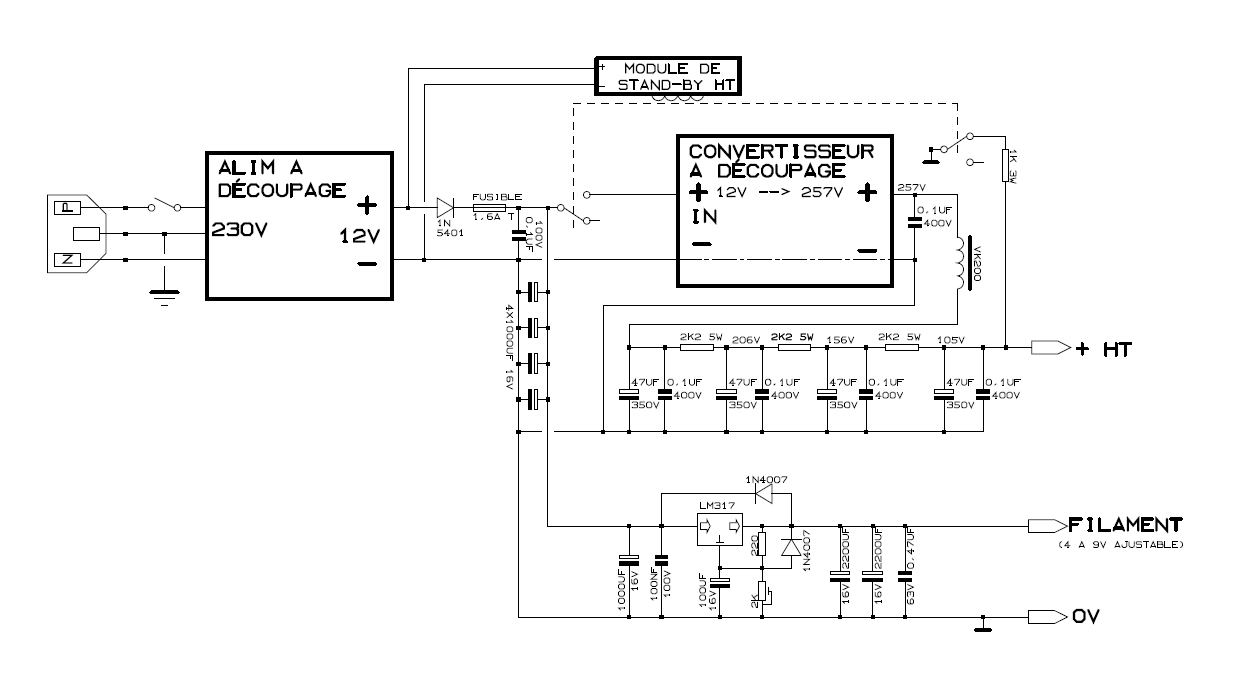
Bernard
http://sonotrad.org --- http://diato.org --- "Collectionneur" de tables numériques Innovason et de micros DIY --- Fer à souder toujours chaud...
scare
En sortie du convertisseur, tu mets la masse uniquement sur le Condo en // sur le 257 V et à rien d autre.
En gros tu supprimes le fil de masse qui passe sous le convertisseur dans ton dernier schéma
Ça te fait une masse en étoile à partir du 0,1 uF en // du fusible. Cette masse distribue la ht, le heater et le convertisseur, et ça t affranchi d histoire de confiance sur la liaison de masse du convertisseur. Pas de boucle. Et c est hyper propre.
Construction du nouveau studio
Visitez le site THD STUDIO / page FB THD Studio
Dossier : Conversion analogique-numérique (pour les courageux)
Taffer
En regardant le schéma de Berl, je m'interroge sur la "plus-value" d'une alim à découpage...
Pardonnez mon ignorance mais, j'ai l'impression que les "rectangles" schématisant l'alim à découpage et le convertisseur, pourraient être remplacé par deux transformateurs 230/12V dont un monté à l'envers (si il accepte l'intensité nécessaire pour le U47...)tel que l'alim du Gyraf G7...
Comme je me dis que si vous faites ce choix, ce n'est surement pas pour rien... Je serais très curieux de le comprendre ...
Je suis CHARLIE
Rémy M. (chimimic)
Formateur en techniques sonores ; électronicien ; auteur @ sonelec-musique.com
Taffer
Encombrement et prix ?
C'est effectivement un argument non négligeable !
Mais, technologiquement ? Pas de plus-values ?
Je suis CHARLIE
berl
C'est aussi plus simple, j'avais ça sous le coude (j'ai aussi les transfos d'ailleurs) et j'ai eu pas mal de problèmes de buzz avec les transfos, jamais avec les alims à découpage. C'est ce qu'utilise par ailleurs Phil29 avec succès, et j'aime aussi expérimenter.
J'aime pas mettre des blindages entre transfo et filtrage, mécaniquement c'est barbant et ça prend plein de place.
Tu en penses quoi ? Bicoze si tu veux tester, j'ai quelques adresses pour des modules HT très bon marché qui produisent quelques mA pour quelques euros à partir de 12,6V
Bernard
http://sonotrad.org --- http://diato.org --- "Collectionneur" de tables numériques Innovason et de micros DIY --- Fer à souder toujours chaud...
[ Dernière édition du message le 02/10/2014 à 12:26:27 ]
Taffer
mais aussi l'absence de régulation de la HT sauf si (re-belote) tu ajoutes une petite régulation.
Là, en effet, cela devient intéressant si la HT est régulée par l'alim à découpage !...
Du coup, je pourrais bien être intéressé si, pour la HT, je peux la régulé à volonté sans aucuns bruits de 90Vdc à 250Vdc tout cela dans un espace réduit...
Je suis CHARLIE
[ Dernière édition du message le 02/10/2014 à 14:48:05 ]
berl
Bernard
http://sonotrad.org --- http://diato.org --- "Collectionneur" de tables numériques Innovason et de micros DIY --- Fer à souder toujours chaud...
[ Dernière édition du message le 02/10/2014 à 18:39:21 ]
Taffer
Le module convertisseur est alimenté en 9-24V et réglable de 200 à 450V par potard multitours.
Merci pour le lien Berl !
Je testerais certainement !
Je suis CHARLIE
berl
Pour un (ou des) micro(s), un module plus petit convient mieux et coutera moins cher.
Bernard
http://sonotrad.org --- http://diato.org --- "Collectionneur" de tables numériques Innovason et de micros DIY --- Fer à souder toujours chaud...
Taffer
Pour un (ou des) micro(s)
Tu penses que l'on peut alimenter plusieurs micros avec une seule alim à découpage sans soucis de "diaphonie" d'un micro à l'autre ?
En gros, si je prends la première alim que tu proposes, que je la règle à 240 Vdc (si j'ai bien compris, 240 Vdc régulée du coup...) et qu'ensuite je dispatche le jus sur 4 circuits RC qui me permettent d'alimenter , et de régler via potentiomètre, individuellement 4 mics en HT (ex: 1ier à 105 Vdc second à 120 Vdc etc...), cela ne poserait aucuns soucis audios sur le son de chaque micros ?
Je suis CHARLIE
berl
Pense que les circuits RC sont faits pour supprimer le ronflement de redressement à 100Hz à l'origine, pas de risque avec une ou 2 cellules RC et des condos suffisants (> 22uF).
Mais la tension sera dépendante de la consommation du micro.
Bernard
http://sonotrad.org --- http://diato.org --- "Collectionneur" de tables numériques Innovason et de micros DIY --- Fer à souder toujours chaud...
Taffer
Mais la tension sera dépendante de la consommation du micro.
Régulée en sortie d'alim à découpage (ex : 220 Vdc) puis dépendante de mon circuit RC et de la conso du micro qui suivent... C'est bien cela ?
Je suis CHARLIE
- < Liste des sujets
- Charte

